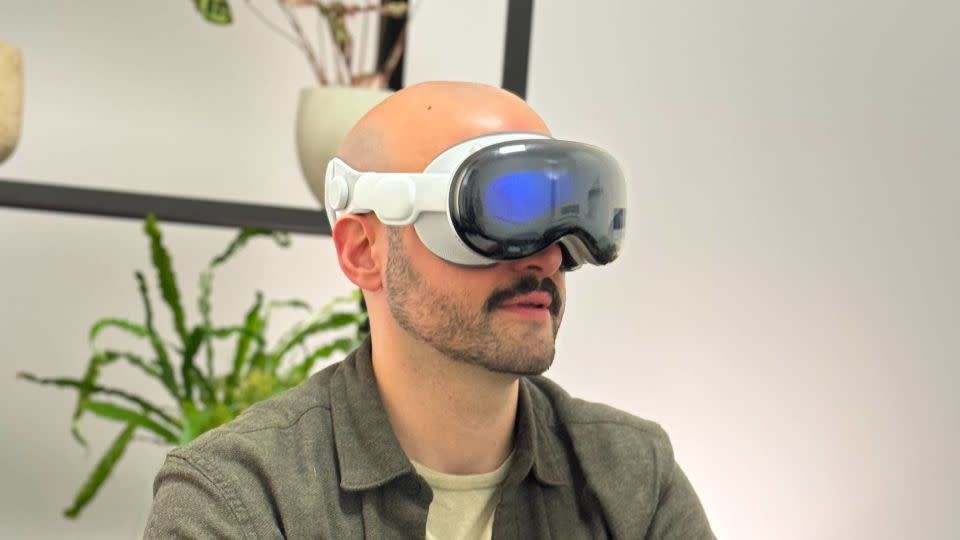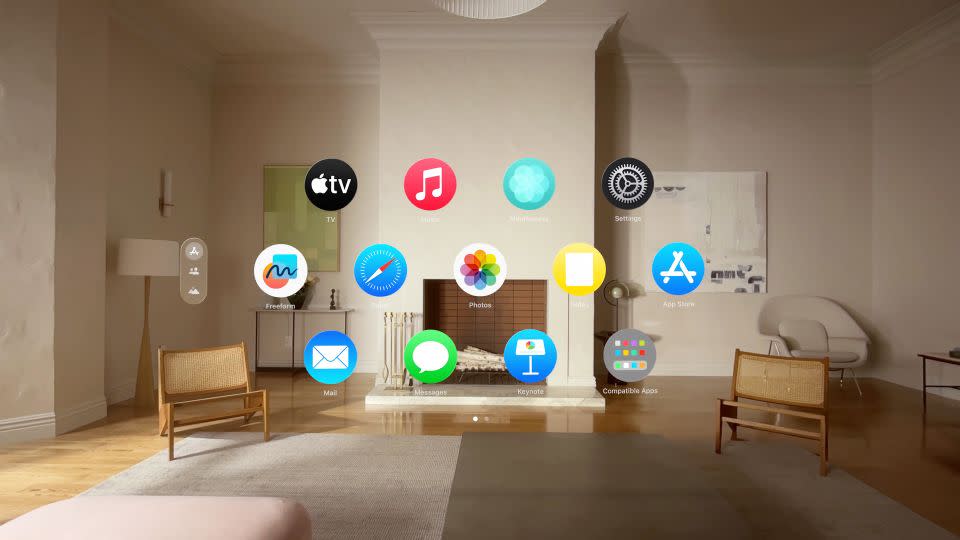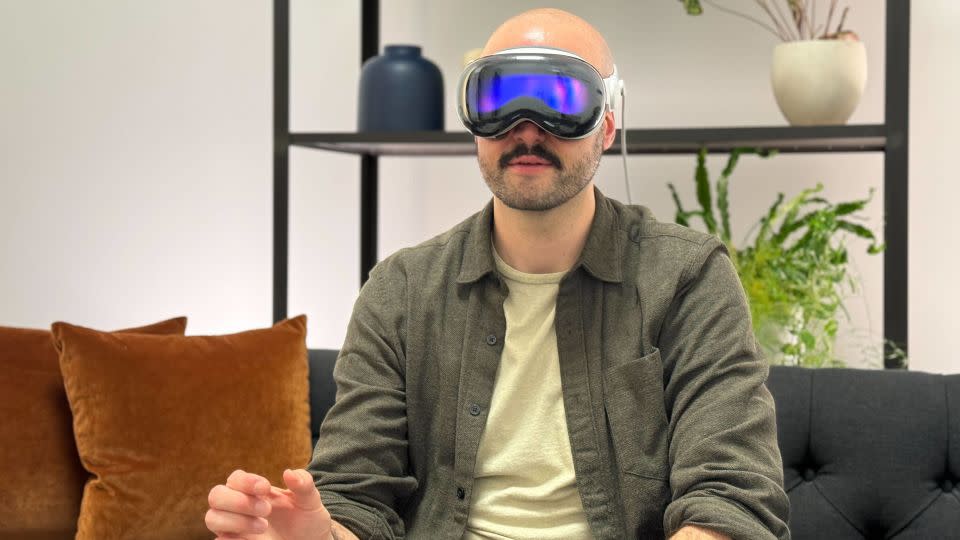I just tried Apple Vision Pro — here’s what I think of this $3,500 headset so far
Content is created by CNN Underscored’s team of editors who work independently from the CNN newsroom. When you buy through links on our site, CNN and its syndication partners may earn a commission. Learn more

During my time with Apple Vision Pro, I sat in the studio with Alicia Keys during a private rehearsal, carefully approached a dinosaur and watched movies in Avengers Tower. But what’s stuck with me isn’t these immersive experiences — it’s the fact that Apple has made using a VR headset feel as intuitive as swiping around your iPhone. And while that alone might not be worth $3,500, it certainly has me intrigued at the potential of this fancy set of goggles.
Apple’s much-hyped “spatial computing” headset has plenty of exciting capabilities, from putting you in a virtual, customizable movie theater to doubling as a full-on computer that lets you get work done, browse the web and use familiar Apple apps in new and engrossing ways. There’s not much of a learning curve either; navigating this device is often as simple as looking around and pinching your fingers.
But does all of that warrant its staggering price? And out of the folks who do have that kind of cash to spend, who should actually buy one? Here’s my attempt at answering those questions after some brief hands-on time with Apple’s long-awaited headset.
Apple Vision Pro

Available starting Feb. 2, the Apple Vision Pro is an immersive "spatial computing" headset that lets you watch movies, play games, get work done and use your go-to Apple apps in a whole new way.
An iPhone on your face

Apple Vision Pro may be a new type of product from the company, but the process of using one will feel pretty familiar to anyone already deep in the Apple ecosystem. Before I put the headset on, I used an iPhone to scan my face to ensure the experience was properly personalized — just like you do when setting up Face ID on your handset.
It was then time to sit down and strap the thing on. The headset’s default medium Solo Knit band turned out to be too big for me, so I simply popped it off and swapped in a small option that fit much better. The straps attach and detach with an easy magnetic snap, not all too different than swapping out Apple Watch bands. I used the onboard dial to tighten the band a bit further for a snug fit, pressed the headset’s Digital Crown button and felt the internal lenses automatically close in on my eyes. Then, it was time to play.

The Vision Pro’s home screen is likewise familiar: a floating array of apps like Photos, Safari, Apple TV and Music that look exactly like they do on your iPhone or iPad. Except instead of swiping around a touchscreen, you’re navigating with your eyes.
By far, this is what impressed me most about Apple’s headset — your eyes are effectively the mouse cursor, and anything you look at will instantly be highlighted and ready to be selected with a quick pinch of your finger. There was something surreal about smoothly bouncing between Apple TV’s various options just by moving my eyeballs, and aside from a few minor hiccups, using gesture controls to open apps, resize and arrange multiple windows and zoom into the finer details of my photo library all felt smooth and intuitive. I’ve experienced solid eye tracking on VR headsets like the Meta Quest Pro and PlayStation VR, but Apple’s implementation provides the most frictionless controller-free navigation I’ve ever seen.

Thanks to the Vision Pro’s outward-pointing cameras, I could easily see and interact with the Apple reps in front of me while bouncing between apps. It’s similar to the Meta Quest 3’s passthrough capabilities, but everything looked a bit sharper. You don’t have to stay in the real world while on the home screen, though; the Digital Crown lets you finely adjust how much of your chosen virtual environment (such as the serene views from Haleakala I selected) seeps through. This is a nice edge over the Quest 3, which only lets you choose between full immersion and full passthrough.
As for how Vision Pro feels to wear? I’ll have to get my own unit to see how it holds up over prolonged use, but I found Apple’s headset to be fairly comfortable during my roughly 25-minute demo — at least in terms of weight. I did have an issue with the lenses, which pinched my nose a little too tightly during the initial setup process and stayed that way throughout my session. Thankfully, an Apple rep noted that you can manually adjust the lens distance in the settings menu, and that there will be multiple eye insert options you can switch between to find a comfortable fit.
Immersive apps with some serious potential

The content I tried out on Apple Vision Pro largely fell into two categories: new, immersive versions of things you can already do on your other Apple devices, and a few custom-made experiences that have me intrigued about the potential of this powerful and pricey headset.
I started out by flipping through the headset’s Photos library, where you can see your pictures and videos in ways that a static screen simply doesn’t allow for. Zooming into a series of portraits shot on an iPhone 15 Pro revealed much more detail than I’d be able to see on just my phone, as I could easily make out the very fine patterning of a woman’s dress. Looking through panoramic photos reminded me of being inside the mind-boggling venue of The Sphere in Las Vegas, as my entire peripheral vision was suddenly immersed in these beautiful wide-screen nature shots.
Then there’s Spatial Photo and Video, which Apple is pushing as one of Vision Pro’s key selling points. These 3D photos and videos can be captured on your iPhone 15 Pro or directly on your headset, then played back on your Vision Pro to let you relive a cool memory in virtual reality. It certainly was neat — a photo of kids eating cake had lots of depth to it, and when one of them blew bubbles in a video, it looked as if the bubbles were coming toward me. I watched one spatial video recorded at a family’s dinner table, and it almost made me feel like I was there with them. The overall quality of Spatial Photo and Video is impressive but not quite so good that I forgot I was watching a video rather than actually reliving a memory.
Apple Vision Pro is perhaps best suited as an immersive movie-watching device, at least if my short time in the headset is any indication. The Apple TV app provides a wealth of engrossing viewing options, many of which effectively let you block out the real world and enjoy your own personalized movie theater or stream your favorite shows while in the virtual wilderness. I was especially impressed by the multiple “seating” options (such as “front row” or “balcony”) that I was able to switch between while watching Avatar: The Way of Water in 3D at a crisp-looking 4K resolution.
I also checked out a few three-dimensional Apple Immersive Videos shot specifically for Vision Pro. These were neat; I had front row seats to an Alicia Keys jam session, got a bit unnerved watching a tightrope walker at the top of a mountain and smiled as a bloat of baby hippos practically ran into me. However, these weren’t true 360-degree videos, and the large black borders I noticed whenever I moved my head around took me out of the experience a bit.

But the real magic happened when I opened up Disney+. My real-world surroundings washed away, and I was suddenly watching movies while overlooking the New York City skyline from Avengers Tower. Needless to say, I geeked out. This virtual environment — one of several available in Disney’s streaming app — was painstakingly detailed to please nerds like me, as I looked around in full 360 degrees to notice things like Doctor Strange’s cape hanging in a corner or some leftover takeout shawarma sitting on a table to my right. These backgrounds are also dynamic; when I transported myself to Tatooine and played a trailer for “A New Hope,” the scene around me automatically shifted from day to night to help me get better immersed in the movie. This felt like an experience truly built for Vision Pro rather than just an iOS app blown up on a big virtual screen, and I hope to see more like it as developers invent for the headset over time.
Another highlight was the Mindfulness app, in which a calming narrator encouraged me to slow down and relax as the real world slowly faded away into a serene darkness where I was surrounded by colorful dots. It was a short session but still very soothing, and much needed after a full day of hustling around the city.
The rest of my demos were a standard mix of Apple stuff and familiar augmented reality experiences. As a taste of the Vision Pro’s enterprise chops, the JigSpace app let me virtually explore, manipulate and take apart an Alfa Romeo vehicle, which I was able to make as small as a toy car or as big as the real thing using simple hand gestures. An app called Explore Dinosaurs thrust me into a mixed-reality wilderness where a virtual butterfly managed to spot and land on my real finger, and where a dinosaur tracked and reacted to my movements as I walked around the room. I got a little spooked when it got right up in my face, which means it worked.
Then there’s the basic Apple functionality. Multitasking between apps and scrolling through the CNN Underscored homepage on Safari felt smooth and intuitive, and I was able to type on a fairly reliable virtual keyboard that felt comparable to the one on the Meta Quest 3. But typing on a virtual keyboard is never ideal, which is why I was pleased to see that you can use voice dictation in Safari by simply looking at the microphone icon at the top of the browser. Oh, and Apple’s own hardware — such as its mice and keyboards — is also supported. This headset packs the same Apple M2 chip you’ll find in many of the best MacBooks, so it’s no surprise that juggling and rearranging multiple apps felt instant and stutter-free.
Some uncanny concerns

I had a good time inside of the Apple Vision Pro, but a few concerns came to mind after I watched another person use the headset. After my demo, I was taken to a room where someone was working with a Vision Pro on (complete with a Magic Keyboard and Magic Trackpad) in order to simulate how you might interact with someone wearing the goggles in an office. Due to the headset’s ability to create a virtual representation of your face, which Apple calls Persona, I was actually able to see this person’s eye movements and expressions through the front of the headset — or at least an uncanny digitized version of them. While I could indeed make out every blink and raised eye this person made, it was all just slightly off in a creepy, “Black Mirror” kind of way. For what it’s worth, you can use the Digital Crown to adjust how visible your “eyes” are through the headset — the idea being that you’ll make things fully opaque to indicate you’re going heads down and clear when you’re able to talk.
Apple also showed off what taking photos and videos looks like to the person on the other end; a quick white flash for the former and a prolonged pulse for the latter. You’ll also hear the standard iPhone shutter sound when someone takes a picture. Unlike the flash, this sound can be disabled (much like it can on an iPhone). I find this to be a slight privacy concern for folks who are unaware that they’re being photographed, but it is in line with devices that have similar functionality, such as the Ray-Ban Meta smart glasses.
The takeaway

I came away from my Apple Vision Pro demo impressed and intrigued, but I still have plenty of questions and concerns. Here’s what I do know: Apple has successfully made a mixed-reality headset that’s nearly as intuitive to use as an iPhone or a Mac, all without any cumbersome controllers or unreliable gesture tracking (like with Meta’s headsets) to get in your way. If nothing else, that lays the groundwork for how great the Vision Pro could be after a few iterations, and hopefully a lower price.
Its $3,500 cost alone will likely be prohibitive for many, though this is a device that can ostensibly function as your 4K TV and your computer — two types of products that can easily run you thousands of dollars on their own. The question is, are you willing to have your TV and your computer strapped to your face, with device-specific quirks and limited battery life? Unless you’re an avid Apple enthusiast with an unlimited budget, it’s hard to imagine who might fall into that camp.
I also have questions around fitness and gaming — two things I use my Meta Quest 3 for almost daily. Aside from Super Fruit Ninja, I haven’t seen many titles that look to take advantage of Vision Pro’s powerful ability to bring virtual games into your real-world living space. And as an avid Supernatural user, the Vision Pro doesn’t seem to have comparable apps that’ll get me excited to work out (no offense to the Apple Fitness+ trainers).
It’s for these reasons that I’m especially eager to truly live with the Vision Pro for a few weeks and see if it’ll truly become part of my daily routine or just a fun, expensive toy to use when I want to return to Avengers Tower. We’ll have a lot more to say on Apple’s new headset once we receive one, so stay tuned for more.
Apple USB-C Charge Cable

You can never have too many charging cables, and this handy 2-meter cord is long enough to comfortably power your Vision Pro while also charging up your iPhone 15, iPad, MacBook and more.
AirPods Pro 2 With USB-C

Our favorite wireless earbuds for Apple users, the AirPods Pro 2 with USB-C are an especially great companion for Vision Pro, thanks to support for high-quality lossless audio.
Apple Magic Keyboard With Touch ID

If you plan on using your Vision Pro for productivity, Apple's popular Magic Keyboard will let you type away on as many virtual screens as you like.
Apple Magic Mouse

As great as the Vision Pro's eye tracking is, sometimes you just need a good mouse to get around. Power users can combine this with their Magic Keyboard for the ultimate immersive work setup.
Note: The prices above reflect the retailers' listed price at the time of publication.
For more CNN news and newsletters create an account at CNN.com

